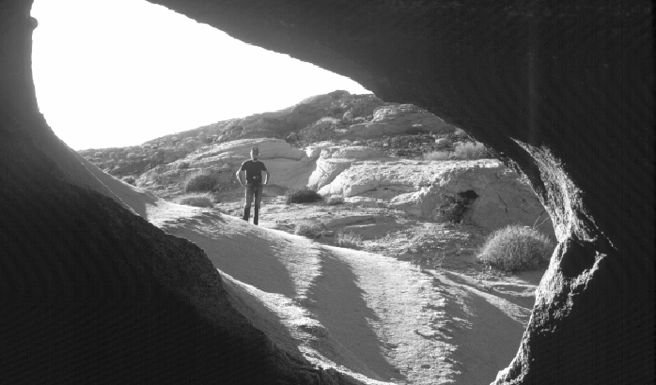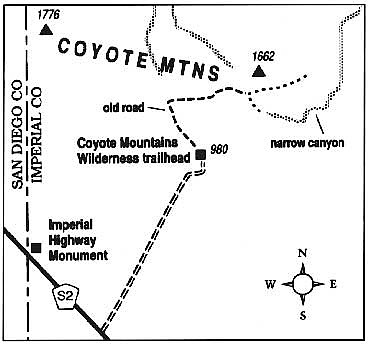 Facebook
Facebook
 X
X
 Instagram
Instagram
 TikTok
TikTok
 Youtube
Youtube

Caught in the grip of faults and folds, the corrugated landscape of the Domelands exposes millions of years of geologic history. This is a good place to view marine fossils aplenty, but you can't collect samples. The area lies in the Coyote Mountains Wilderness, which protects all natural resources -- be they animal, vegetable, or paleontological.
Less than two hours' driving takes you there. Head east on Interstate 8 to Ocotillo, and then northwest on County Highway S-2 for 7.1 miles to the unmarked turnoff, which is a dirt road heading northeast (if you reach the San Diego-Imperial County line, you've gone 1.1 miles too far). Drive 2.0 miles on the somewhat bumpy dirt road to the foot of some yellowish clay hills, where a signboard announces your arrival at the wilderness boundary.
On foot, go uphill (north) on the eroded remnants of a jeep road. At 0.5 mile you pass over a small summit; at 0.8 mile, the remnant road veers right (east) up a sandy wash. At about 1.3 miles you'll see footprints veering left out of the wash and onto a terrace just north of the wash, where again you follow the remnant road. By 1.6 miles you reach the foot of a rocky slope, and your choices for further exploration include at least these two options:
Option 1: Follow a narrow footpath cut obliquely upward along the rocky slope and discover the wonderland of cavernous sandstone domes and outcrops less than a half-mile to the east. One cavelike feature has a sandy floor suitable for a siesta. Enjoy the view over the convoluted Carrizo Badlands to the north. This is surely one of the finest views our local desert has to offer.
Option 2: Veer south and work your way over a series of sharp little ravines 0.2 mile to the rim of a steep basin draining east. Descend from there into what soon becomes a deep cleft. You pass yellow and gray clay deposits, desert-varnished granitic boulders, and sandstone walls tinted various shades of tan and orange. At one point, huge chunks of sandstone have fallen from the walls, creating a "fat-man's misery" situation. Farther down the ravine, the walls separate somewhat, and you discover (among many others wonders) so-called "fossil reefs" -- marine sedimentary rock containing nearly as much fossilized shell material as cemented-together sand and silt. The shellfish represented by these fossils thrived in the warm waters of the ancestral Sea of Cortez, which covered this area during certain intervals over the past several million years.

North of the spectacular Domelands area, the Coyote Mountains Wilderness consists of a relatively unexplored maze of clay hills, or "mud hills," many of them shot through with narrow, sinuous mud caves. Days could be spent wandering here, either by the will of intrepid and informed travelers or lost souls endlessly wandering in search of a way out.


Caught in the grip of faults and folds, the corrugated landscape of the Domelands exposes millions of years of geologic history. This is a good place to view marine fossils aplenty, but you can't collect samples. The area lies in the Coyote Mountains Wilderness, which protects all natural resources -- be they animal, vegetable, or paleontological.
Less than two hours' driving takes you there. Head east on Interstate 8 to Ocotillo, and then northwest on County Highway S-2 for 7.1 miles to the unmarked turnoff, which is a dirt road heading northeast (if you reach the San Diego-Imperial County line, you've gone 1.1 miles too far). Drive 2.0 miles on the somewhat bumpy dirt road to the foot of some yellowish clay hills, where a signboard announces your arrival at the wilderness boundary.
On foot, go uphill (north) on the eroded remnants of a jeep road. At 0.5 mile you pass over a small summit; at 0.8 mile, the remnant road veers right (east) up a sandy wash. At about 1.3 miles you'll see footprints veering left out of the wash and onto a terrace just north of the wash, where again you follow the remnant road. By 1.6 miles you reach the foot of a rocky slope, and your choices for further exploration include at least these two options:
Option 1: Follow a narrow footpath cut obliquely upward along the rocky slope and discover the wonderland of cavernous sandstone domes and outcrops less than a half-mile to the east. One cavelike feature has a sandy floor suitable for a siesta. Enjoy the view over the convoluted Carrizo Badlands to the north. This is surely one of the finest views our local desert has to offer.
Option 2: Veer south and work your way over a series of sharp little ravines 0.2 mile to the rim of a steep basin draining east. Descend from there into what soon becomes a deep cleft. You pass yellow and gray clay deposits, desert-varnished granitic boulders, and sandstone walls tinted various shades of tan and orange. At one point, huge chunks of sandstone have fallen from the walls, creating a "fat-man's misery" situation. Farther down the ravine, the walls separate somewhat, and you discover (among many others wonders) so-called "fossil reefs" -- marine sedimentary rock containing nearly as much fossilized shell material as cemented-together sand and silt. The shellfish represented by these fossils thrived in the warm waters of the ancestral Sea of Cortez, which covered this area during certain intervals over the past several million years.

North of the spectacular Domelands area, the Coyote Mountains Wilderness consists of a relatively unexplored maze of clay hills, or "mud hills," many of them shot through with narrow, sinuous mud caves. Days could be spent wandering here, either by the will of intrepid and informed travelers or lost souls endlessly wandering in search of a way out.
Comments